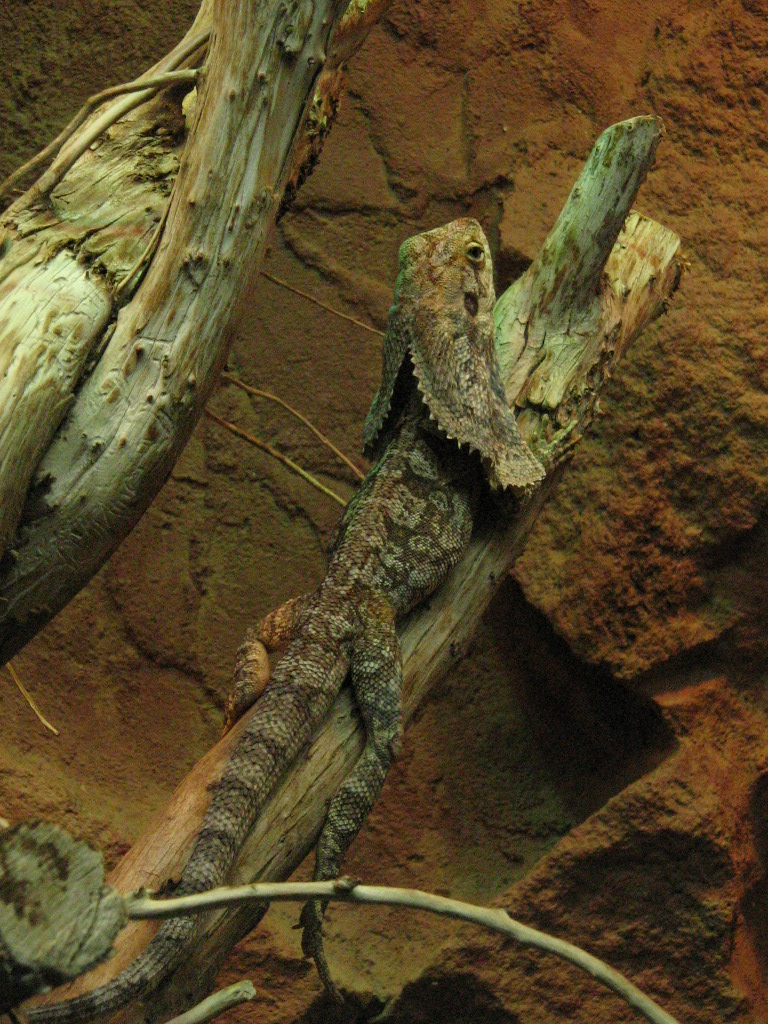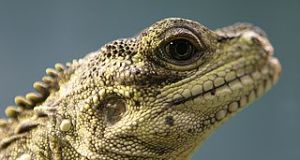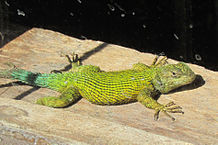General
Although not what might be termed an ideal “first lizard”, frilled dragons make fascinating, long-lived additions to the collections of those with a bit of reptile-keeping experience. This week we’ll take a look at how to provide for these unique animals in captivity. Please see Part I of this article for a discussion of their habits in the wild and history in the pet trade.
dragons make fascinating, long-lived additions to the collections of those with a bit of reptile-keeping experience. This week we’ll take a look at how to provide for these unique animals in captivity. Please see Part I of this article for a discussion of their habits in the wild and history in the pet trade.
Space and Other Physical Requirements
Space requirements are probably the main drawback to this species’ suitability as a pet. Males can exceed 3 feet in length, and neither they nor females take well to cramped quarters. Although not particularly active, wild frilled dragons cover large distances in the course of their seasonal movements, traveling from the forest canopy to tree trunks within 15 feet of the ground. They do not actively hunt their prey, but leap to the ground to chase passing insects from their arboreal perches, expending a good deal of energy in the process. Perhaps these lifestyle peculiarities explain in part their need for spacious cages when kept as pets.
Given that frilled dragons are territorial, it is also quite natural that they will instinctively feel stressed without adequate space, even if provided with ample food and protected from competition. Territorial animals almost always need the perception of an adequate space in which to live, despite the fact that their basic needs might, in captivity, be met in a fairly small area. This is an important point to bear in mind when keeping any animal – I have found the principle invaluable in dealing with creatures ranging from tiny insects to large mammals.
Hatchlings can be raised for a time in a 20 gallon aquarium, and a pair of sub-adults can get by in a tank of 55-75 gallon capacity. Adults, however, require a custom or self-built screen cage of at least 3 feet square and 4 feet in height. In all cases, climbing space is more important than floor area.
The cage should be well-stocked with stout, vertically oriented branches, in imitation of the lizards’ natural tree trunk habitat. Be certain that several basking sites are provided if you keep more than 1 animal, and take care to observe that each individual is basking regularly. Dominant animals of either sex may, by their mere presence or actual aggression, prevent others from utilizing the basking sites. The actual perch that is to be used as a basking area should be positioned so that it is an optimal distance (as regards UVB output) from the light source. This distance is less than 12 inches for most fluorescent bulbs (but check manufacturer’s recommendation) and may be greater for certain incandescent UVB emitting models.
Frilled dragons rely largely upon camouflage for protection, and will feel comfortable “hiding” on their perches. However, particularly high-strung individuals should be given the opportunity to shelter beneath artificial plants suspended from the branches. If you are using a screen cage, please bear in mind that one side of the enclosure should be a solid wall, or should be rendered so by a piece of canvas or the like. It is a rare animal that feels at ease when completely exposed on all 4 sides – frilled dragons and other lizards are particularly sensitive in this regard. Again, this is a general principle, applicable across most of the animal kingdom – adhering to it will go a long way in your efforts to habituate wild creatures to captivity (and, ultimately, will contribute to success in breeding efforts).
A mulch-type substrate, such as Keeper’s Choice Tropical Red Cypress Bedding, should cover the cage floor.
Light, Heat and Humidity
Frilled dragons bask frequently, and should have access to a high quality UVB source, such as R Zilla’s 7% Desert UVB Bulb (although not a desert dwelling species, frilled dragons have high UVB requirements) and a full spectrum bulb providing UVA as well. The basking site’s temperature should be 95-100 F, with the rest of the cage maintained in the range of 75-82 F.
Frilled dragons and their cage should be misted with water once or twice daily. Although they often live in habitats devoid of standing water, these lizards will soak and so should be provided with a water bowl.
Feeding
The diet should be as varied as possible – crickets, roaches, waxworms, super mealworms, mealworm beetles and silk worms can form the basis. A pink mouse can be given once every 4-6 weeks, but such is not necessary. Frilled dragons will not thrive on a diet consisting of crickets and super mealworms. Frequent feedings of pink mice or other vertebrates may result in kidney, liver and eye (fatty deposits in the cornea) problems. Field studies have revealed that, while frilled dragons eagerly consume small vertebrates, insects and other invertebrates make up the overwhelming majority of the diet. Their systems are not designed to process a diet rich in mice and other rodents, and, indeed, they get along perfectly well without them in captivity.
Please try to provide wild-caught insects whenever possible. Mine especially favor grasshoppers, katydids, large moths and cicadas. Avoid fireflies, brightly colored insects (due to possible toxicity) and bees, wasps and spiders. Zoo-Med’s Bug Napper is an excellent insect trap, and should be utilized by all serious lizard-keepers.
Some frilled dragons take plant foods, although in my experience they have been few and far between. I suggest trying dandelion flowers, collard, mustard and turnip greens, diced carrot, yam, squash and fruit. Little is known of their preferences for plant foods in the wild.
The food should be powdered with a high quality vitamin/mineral supplement – twice weekly for adults and 4-5 times weekly for hatchlings and gravid females.
Adults can be fed small daily meals, with occasional fast days, or 3-4 times weekly. Hatchlings and growing animals do best when fed 5-7 times per week.
Social Grouping
Hatchlings can be reared together for a time, but hierarchies develop early and smaller animals will not fare well. Males cannot be housed together, but females may co-exist if similarly sized and given adequate space. Watch that all animals are getting enough to eat and are able to bask – even absent outright aggression, subordinate animals may be inhibited by cage-mates.
Captive Longevity
Captive longevity exceeds 15 years; unknown in the wild
Handling and Enrichment
Filled dragons take fairly long in accepting handling, and should be approached with care. While impressive, the flaring of their neck frill is a sign of stress and should not be induced. Even long-term captives react with fear to unexpected movements or noises, and they can administer a painful bite. Well-habituated individuals become quite tame and may be gently handled and hand-fed.
Breeding
Breeding will be covered in greater detail in the future. Frilled dragons may attempt to before fully mature, which leads to egg-retention and other problems. It is safest to keep the sexes separate until maturity is reached.
The abstract to an interesting article on frilled dragons in the wild is posted at:
http://www.jstor.org/pss/1447984 . Please also see Part I of this article for links to field studies.
 That Reptile Blog – Reptile, Amphibian and Exotic Pet Care and Information
That Reptile Blog – Reptile, Amphibian and Exotic Pet Care and Information




Frillies are very cool, however I find interesting that they are actually falling a bit out of popularity when compared how they were just a few years ago. Here it appears that many hard core lizard guys moved into things like rare monitors like kimberlys and left frillies. I think that the large farm raised imports from indonesia have to do with it, making the market value going down, and also that more people are raising and breeding them on a regular basis. On the other hand they are not a begginers like a beardy, they fall somewhere in the midle and so they are not a massive market lizard.
Cheers
Same here…when frilled lizards first entered the trade we (zoo) paid $1,500 each for hatchlings, demand down now.
Frank which do you prefer Australian or New Guinea in terms of keeping on captivity? I understand that the New Guinea’s are a bit smaller with different color variation, and different requirements for temperature/humidity, but those are the only differences I have found.
Thank you
hello Kevin,
Those I’ve kept long term were in zoos, mainly originating in Australia (confiscations); I don’t know of any major differences other than what you’ve mentioned, best, Frank